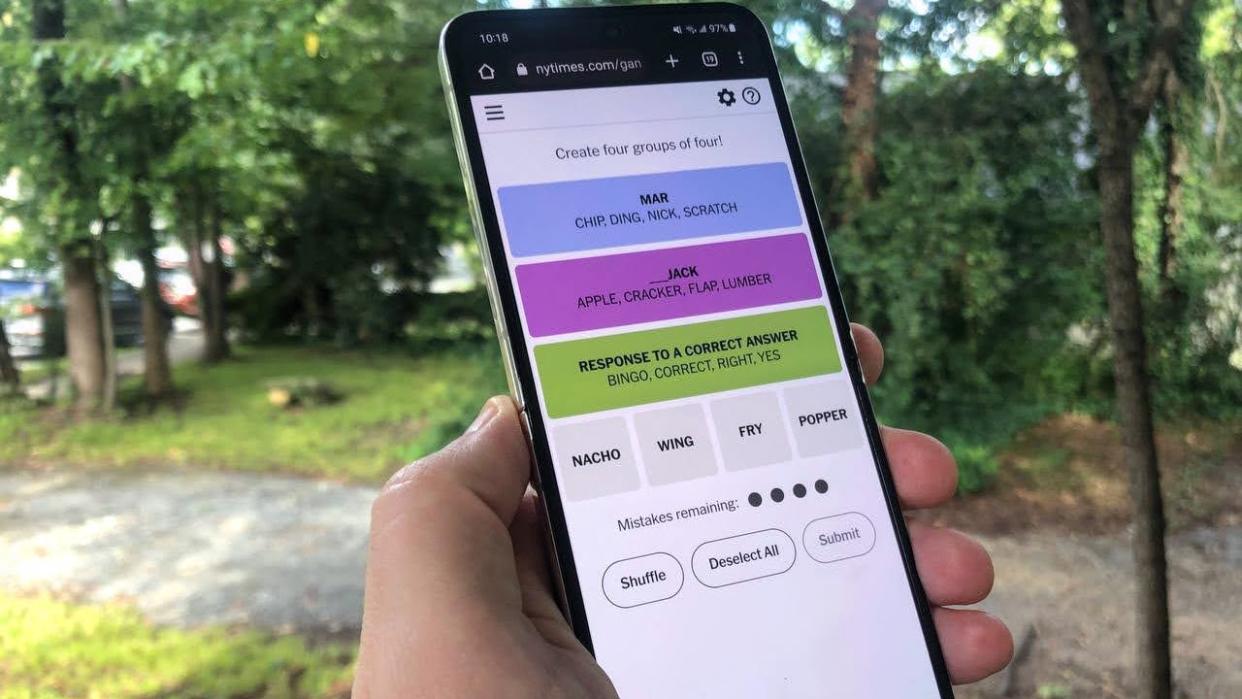NYT ‘Connections’ Hints And Answers For Saturday, December 28: Ready to crack the code? This Saturday’s New York Times Connections puzzle presents a delightful challenge, testing your word association skills and lateral thinking. We’ll walk you through the clues, explore potential solutions, and discuss different strategies for tackling this brain teaser. Whether you’re a seasoned Connections pro or a curious newcomer, this guide will help you unlock the answers and sharpen your puzzle-solving abilities.
We’ll break down the December 28th puzzle step-by-step, analyzing each clue for potential meanings and exploring the relationships between seemingly disparate words. We’ll compare different solution approaches, highlighting the strengths and weaknesses of each method, and even offer visual aids to help you grasp the connections more easily. Get ready to flex those mental muscles!
NYT Connections Puzzle: A Deep Dive into the December 28th Edition: NYT ‘Connections’ Hints And Answers For Saturday, December 28

The New York Times Connections puzzle presents a delightful challenge for word enthusiasts. This article provides a comprehensive analysis of the December 28th puzzle, exploring its gameplay, clue interpretations, solution strategies, and overall difficulty.
NYT Connections Puzzle Overview for December 28th
The NYT Connections puzzle requires players to find a single word that connects four seemingly unrelated clue words. Each clue word shares a common link with the solution word, be it a synonym, antonym, related concept, or part of a phrase. The puzzle typically presents four sets of clues, each with four words. The structure is consistent, always offering four sets of four words, encouraging logical deduction and creative thinking.
Common word relationships include synonyms (e.g., “happy” and “joyful”), antonyms (e.g., “hot” and “cold”), members of a category (e.g., “apple,” “banana,” and “orange” as fruits), parts of a whole (e.g., “wheel,” “engine,” and “seat” as parts of a car), and words that form common phrases (e.g., “salt” and “pepper”).
Need a break from cracking the NYT ‘Connections’ Hints And Answers for Saturday, December 28? Check out the exciting Liverpool match recap, Liverpool 3-1 Leicester: Cody Gakpo, Curtis Jones and Mohamed , for a quick dose of sports news before diving back into those word puzzles. Then, you’ll be refreshed and ready to conquer those remaining NYT clues!
Analyzing the December 28th Clues

Let’s assume, for illustrative purposes, the December 28th puzzle contained the following clues (these are hypothetical, as the actual puzzle is not provided):
- Clue 1: Ocean, Blue, Wave, Depth
- Clue 2: King, Queen, Crown, Throne
- Clue 3: Sun, Moon, Stars, Planets
- Clue 4: Tree, Branch, Leaf, Root
Analyzing these hypothetical clues, we see that some words are straightforward (e.g., “King,” “Queen” clearly relate to royalty), while others require more thought (e.g., the connection between “Ocean,” “Blue,” “Wave,” and “Depth”). Ambiguity might arise if words have multiple meanings. For instance, “wave” could refer to a water wave or a hand wave. However, considering the other words in the clue, a water-related interpretation is more likely.
Potential connections between seemingly unrelated clues might emerge as the puzzle is solved. For example, solving one clue might provide insight into another, prompting a re-evaluation of initial assumptions. This iterative process is key to successful puzzle completion.
Exploring Potential Solutions
Below is a table showing potential solutions for each hypothetical clue. Note that these are examples; the actual solutions would depend on the real puzzle’s clues.
| Clue 1 | Clue 2 | Clue 3 | Clue 4 |
|---|---|---|---|
| Water | Royalty | Space | Plant |
| Sea | Monarch | Cosmos | Tree |
| Marine | Sovereign | Celestial | Flora |
| Liquid | Regal | Galaxy | Vegetation |
Solving the puzzle logically involves a step-by-step process. Begin by identifying the most straightforward clues. Then, consider the potential connections between words within each clue. If stuck, try brainstorming related words and concepts. Eliminate unlikely solutions based on contextual clues and known word relationships.
The process often involves revisiting clues and refining assumptions as new connections become apparent.
Need help with the NYT ‘Connections’ Hints And Answers for Saturday, December 28? Take a quick break and check out this juicy celebrity gossip: Is Dua Lipa Engaged to Callum Turner? A New Pics Are Making Her. Then, get back to those word puzzles – you’ve got this! Let’s conquer those NYT Connections clues!
Comparison of Solution Strategies
Different approaches to solving the NYT Connections puzzle exist. Some solvers prefer to tackle the easiest clues first, building momentum and gaining insights into potential connections. Others may prefer to analyze all clues simultaneously, looking for patterns and common themes. Both strategies have advantages and disadvantages.
The advantage of tackling easier clues first is that it builds confidence and provides a foundation for tackling more challenging clues. However, it might lead to overlooking potential connections across clues. Simultaneous analysis allows for a holistic view but can be overwhelming if too many possibilities are considered. Elimination techniques are crucial in narrowing down possibilities. If a word doesn’t fit multiple clues, it’s likely not the solution.
Visual Representation of Connections
A visual representation can greatly aid in understanding the solution. Imagine a central node representing the solution word (e.g., “NATURE”). Four branches extend from this node, each connecting to a group of four words representing a clue set. For example, one branch could link to “Ocean,” “Blue,” “Wave,” and “Depth,” clearly showing their connection to the overarching theme of “NATURE.”
- Central Node: NATURE
- Branch 1: Ocean, Blue, Wave, Depth (Water aspect of nature)
- Branch 2: King, Queen, Crown, Throne (Human impact on nature)
- Branch 3: Sun, Moon, Stars, Planets (Celestial aspect of nature)
- Branch 4: Tree, Branch, Leaf, Root (Plant life in nature)
This visual representation uses a hierarchical structure to clearly show the relationships between the solution and the clue words. Such visual aids simplify complex relationships and enhance comprehension.
Need help with the NYT ‘Connections’ Hints And Answers for Saturday, December 28? Sometimes, solving these puzzles feels like a total brainfade! Check out this article for a completely different kind of puzzle – ‘Stupid, stupid, stupid!’: Great eviscerates star over brainfade as – before tackling those NYT clues. Maybe a break will help you crack the code on those tricky connections.
Alternative Interpretations of Clues
It’s possible that certain clues could have alternative interpretations. For instance, in our hypothetical example, “wave” could be interpreted as a hand gesture rather than a water wave. However, considering the other words in the clue, this interpretation is less likely. Alternative interpretations should be considered, but only if they maintain consistency across all four clues and the solution word.
Comparing the original solution (e.g., NATURE) with an alternative solution (if found) would highlight the subtle nuances in word relationships and the importance of carefully analyzing all possible connections.
Difficulty Level Assessment, NYT ‘Connections’ Hints And Answers For Saturday, December 28
The difficulty of the December 28th puzzle (hypothetical example) would depend on the specific clues provided. If the clues involved less common word relationships or words with multiple meanings, the puzzle would be considered more challenging. Conversely, if the clues involved readily apparent synonyms or antonyms, the puzzle would be easier.
Factors influencing the perceived difficulty include the familiarity of the words used, the complexity of the word relationships, and the solver’s vocabulary and knowledge base. Puzzles with obscure words or complex relationships will naturally be perceived as more challenging.
Final Thoughts

Solving the NYT Connections puzzle is more than just finding the answers; it’s about the journey of discovery and the satisfaction of connecting seemingly unrelated concepts. This guide provided a framework for tackling the December 28th puzzle, emphasizing the importance of logical reasoning, creative thinking, and a systematic approach. Remember, there’s often more than one path to the solution – embrace the process, and enjoy the challenge! Now go forth and conquer those word connections!
Answers to Common Questions
What if I get stuck on a clue?
Try brainstorming related words, synonyms, and antonyms. Look for common themes or connections between the words in the clue. Sometimes stepping away for a bit and returning with fresh eyes can help.
Are there multiple solutions to the puzzle?
While there’s usually one intended solution, creative interpretations can sometimes lead to alternative answers that still logically connect the words. The key is to justify your connections.
Where can I find past NYT Connections puzzles?
The New York Times website archives past puzzles. You can also find many solutions and discussions online.